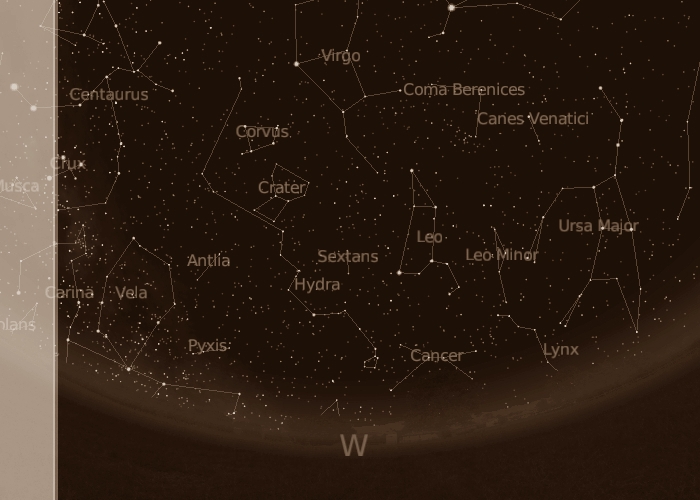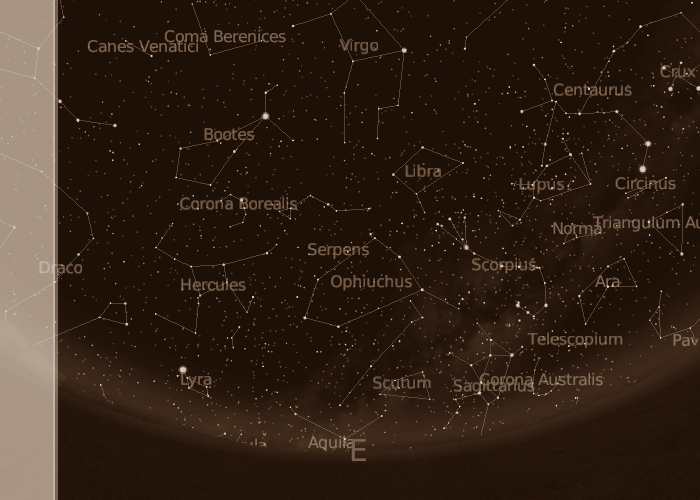Western Horizon
Eastern Horizon
![]()
Western Horizon
Eastern Horizon

We are seeing the skies of the vernal equinox. Such skies at the tropics, have the show mostly South. Let's turn South! It's there that you'll find this remarkable, large band of Milky Way-embedded typically southern constellations. That's a fine show! Running from Sagittarius, the Archer, to the last stars of Puppis, the Ship's Stern. Scorpion, the Scorpion, southeast, is now well risen. Ara, the Altar, is seen below. After Lupus, the Wolf, it's Centaurus, the Centaur, and the Pointers. The Pointers -Alpha and Beta Centauri that is- are those stars which are 'pointing' to Crux, the Southern Cross, hence their name. Alpha Centauri in itself, is a multiple stars system, one of which is Proxima Centauri, the star nearest to Earth, by 4.3 light years. Let's keep on! There is Crux, the Southern Cross, which helps to find the northern celestial pole! A famed globular cluster, Omega Centauri (NGC 5139), at the magnitude 3.7 is to the upper left of it. The rest of the band, at last, is composed of the constellations which had been bord, in the 18th century, from the antique and vast Argo, the Ship, the ship of the Argonauts, those Greek heroes who went in search of the Golden Fleece. Carina, the Ship's Keel, and Vela, the Ship's Sails, are the best available. The row above those Milky Way-embedded constellations is occupied by Hydra, the Hydra, albeit it's now shifting West. Sextans, the Sextant, Crater, the Cup, and Corvus, the Crow, are anchored along its line. Fine! The bright star, high, due South, is Spica, of Virgo, the Virgin. Let's now turn West. Here, you'll check that Hydra is now shifted there and, somehow, tending low. Near Hydra's head, see how Cancer, the Crab, is now low. Leo, the Lion, is now well positioned for observation, as the Great Dipper is to its right. Deep-sky amateurs will find of interest that the deep-sky galaxy fields in Virgo and Coma Berenices are near the zenith, allowing for fine observations. to a printer-friendly chart
West for the mid-northern latitudes. West for the mid-southern latitudes

As the southeastern part of the sky is filled with the left part of the band of Milky Way-embedded constellations, you can spot Libra, the Scales, high, above Scorpio, as Ophiuchus is now well risen, East. Ophiuchus is personalizing Asclepios, the Greek god for medicine who was placed into the sky with its two serpents, he used like herb-finders. The bright star, high, slightly northeast, is Arcturus, of Bootes, the Herdsman. Below it, Hercules, the Heroe, has become a fine target. Hercules is a quadrilateral of stars, with extensions. Hercules is known too to harbour the famed globular cluster M13, a fine binocular object. It's now to be found at one-third the length of the upper side of the quadrilateral, beginning at the star left. Those with a good horizon, will be able to catch a bright star in the vicinity. That's Vega, of Lyra, the Lyra. Stars of Draco, the Dragon, are seen northeast, as, further North, the Great Dipper, that distinctive feature of the northern hemisphere is seen, along with the Little Dipper, under it, past the meandering line of Draco. to a printer-friendly chart
East for the mid-northern latitudes. East for the mid-southern latitudes
(color maps with Stellarium; printer-friendly charts with Cartes du Ciel, Patrick Chevalley)
Website Manager: G. Guichard, site 'Amateur Astronomy,' http://stars5.6te.net. Page Editor: G. Guichard. last edited: 12/28/2010. contact us at ggwebsites@outlook.com